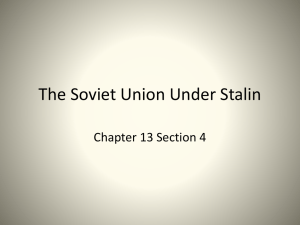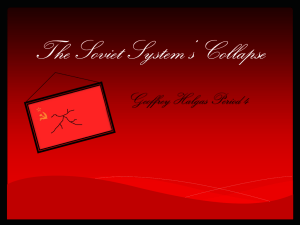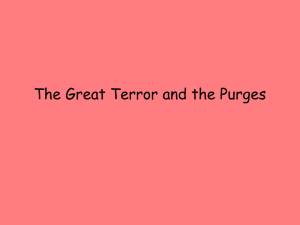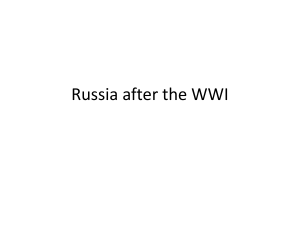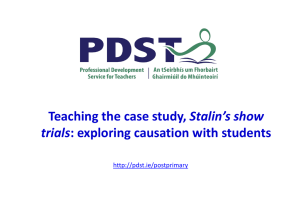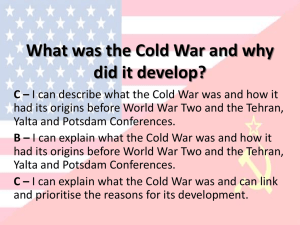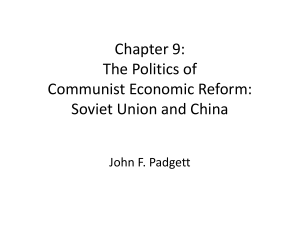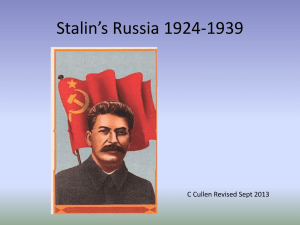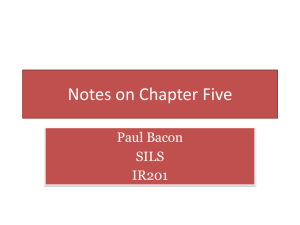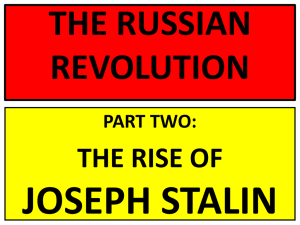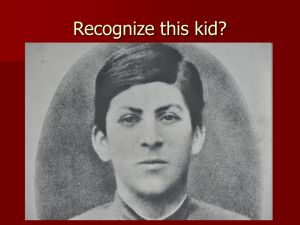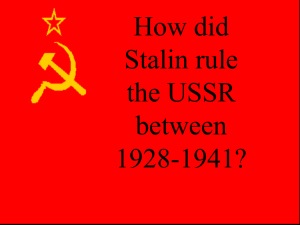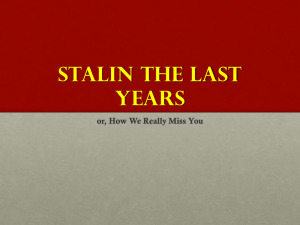The Great Purge
advertisement
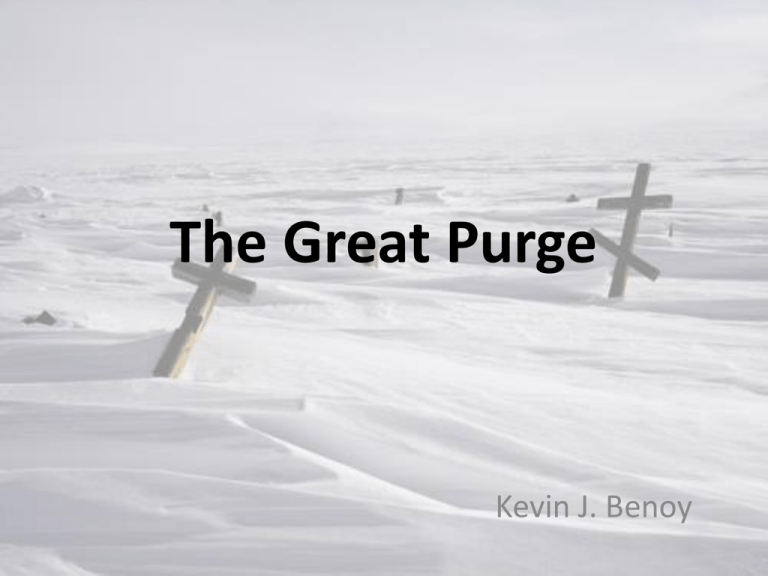
The Great Purge Kevin J. Benoy Introduction • Were it not for the Holocaust, the Soviet Great Purge might be known as history’s most barbaric event Interpretations The Official Soviet View to 1956 • The closer Soviet society moved to socialism, the more desperate the class enemy became. They would do anything to hold back the building of socialism: sabotage, murder of Soviet leaders, collaboration with the secret services of Germany and Japan. As a result, the Party had to fight back. The class struggle sharpened. Interpretations The Soviet View from 1956 to Gorbachev • Stalin did a good job fighting anti-party elements in the 1920s and early 1930. • Hew was also justified in collectivization and industrialization, but owing to problems that arose in these processes and the negative influence of Beria, Stalin became isolated from the party and began persecuting its leading members who became victims of Stalin’s cult of personality Interpretations Since Gorbachev & Glasnost • Stalin made dreadful errors, falsely accusing Party members of crimes they did not commit. • Post communist Russians are divided about him. – Some consider him a monster. – Others feel he may have committed excesses, but only for the greater good of the country. Interpretations Western Perceptions • Some Westerners claim the purges were a manifestation of Stalin’s paranoia – perhaps arising out of syphilis. • Others say that paranoia was indeed the cause – but that it came out of a deep inferiority complex. Interpretations Western Perceptions • Others see a conspiracy at work. • The German Gestapo created havoc by producing convincinglooking documents showing Soviet leaders plotting with the Germans to overthrow Stalin – something confirmed to him by the Czech secret service. Interpretations Western Perceptions • Still others point to the severe strains of collectivization and industrialization in the nation and in the party – even among his own followers • At one stage he even found himself within a minority on the Central Committee and was almost ousted. • This theory insists he turned against those who he felt betrayed him. In a secret ballot of Party members in 1934, Stalin found others were more popular than himself – including his protoge, Kirov – who Stalin then had killed. Origins of the Purge • It is difficult to say exactly when Stalin decided to turn on the Party itself. • He certainly had a pessimistic view of events and people. • The 1932 suicide of his 2nd wife, Nadia Alliluyeva, surely had a great effect. Nadya’s Suicide • Even she had criticized his policies and the terror they brought. • After a family dispute in which he publicly hurled abuse at her, she went home and shot herself. • Stalin was badly shaken – he offered his resignation, but they did not know how to respond and he was persuaded to stay on. • After this point he seemed to lose trust in even his closest friends. 1934 Party Conference • Nonetheless, there seemed no reason to act. • Stalin announced that “there is nothing to prove and, it seems, no one to fight.” • Had not the peasants and workers been beaten into submission? • Even the Politburo now consisted only of Stalin’s cronies – but now some of them began to echo the concerns of the beaten opposition. Kirov’s Murder • Sergei Kirov, Stalin’s apparent favourite, was dispatched to Leningrad to “clean up” Zinoviev supporters there. • On December 1, 1934 he was assassinated by a supposed supporter of Zinoviev. • Hardliner, Andrei Zhdanov, was dispatched to replace Kirov. Kirov’s Murder • Hundreds of “Kirov’s murderers” were rounded up and sent to Sibertia. • Kamenev & Zinoviev themselves were sentenced to long terms for abetting the murder. • Officially, a grief-stricken Stalin allowed a reign of terror to begin. Khruschev, in his secret 1956 speech, hinted that Stalin ordered the murder himself. Purges Begin • Arrests continued in mid 1935 and 1936, but not in large numbers. • Stalin was more interested in the drafting of a new constitution – largely by the disgraced figure, Bukharin. Show Trials • In August, 1936 show trials opened of 16 old Bolsheviks – including Kamenev and Zinoviev. • The Defendants were all convicted and shot. Show Trials • Next it was announced that the 16 implicated others, including Bukharin, Rykov and Tomsky, though the Central Committee rejected the claim. • In January, 1937 trials began for 17 lesser figures. • The accused confessed to even the wildest claims against them and were shot. Show Trials • The third series of trials proved the most dramatic and bizarre. • The accused included: – All of Lenin’s Politburo except Stalin. – Rykov, a former Premier. – Bukharin. – Tukhachevsky, ex-Chief of the General Staff. – Tomsky, ex-Chief of Trade Unions. – Trotsky Show Trials • Arrests developed momentum as the trials began. • They did not end with the elimination of the old Bolsheviks. They included: – 70% of the 1934 Central Committee. – Most high ranking officers and 24% of the military officer corps. – 90% of trade union officials. – Most Soviet ambassadors to Europe and Asia. – Managers, intellectuals and Party and Comintern functionaries. The Purge Expands • Arrests were not limited to Party members. • Millions of ordinary citizens were accused. • Historian Donald Treadgold writes: “orders went out to the secret police to arrest a certain percentage of the whole population varying slightly from district to district. It has been estimated that eight million people were arrested, and the actual total may be higher still.” To this total one must include those who Stalin eliminated by other means – through murder or suicide. Willing Confessions • What astounded the outside world was the readiness of purge victims to confess to even the most ridiculous accusations. • Independent investigations showed many charges to be “physically impossible, meeting at hotels long since dismantled, landing at airports where no such planes has landed and so forth.” Confessions • Confessions were also drawn out by torture – both mental and physical. • Some honestly believed that confessions might bring pardons or lighter sentences – though it soon became clear that prosecutor Vyshinsky’s call to the courts to “shoot the mad dogs” was invariably accepted. Purge document signed by Stalin and others. Confession • Some may have felt that confessions would save their families. Confessions • For some, it was a final service to the Party. • Perhaps they would be the last scapegoats, saving their party and country from further bloodshed. • Perhaps this was a necessary historical phase, despite unfairness to the individual. Zinoviev’s arrest photograph Confessions • As novelist Arthur Koestler suggests in his novel Darkness at Noon, “they were too deeply entangled in their own past, caught in the web they had spun themselves, according to the laws of their own twisted ethics and twisted logic: they were all guilty, although not of these deeds of which they accused themselves. The Unrepentant • For those who would not confess, there were secret trials or even simply executions without trial. • This was the fate of some civilians and all of the military leaders. The Truth? • Was there any truth to the confessions? – In almost all cases there was no objective truth. – They were tried on trumped up charges of which they were innocent. Stalin’s biographer, Isaac Deutscher noted: “They may want to overthrow me in a crisis – I shall charge them with having already made the attempt.” The Truth • In the case of the military, Deutscher believes that there might well have been a real conspiracy. • While some claim that Stalin was fed disinformation by the Gestapo or even by elements of the Soviet Secret police, who feared the military, quite a few non-Stalinist sources maintain the generals did indeed plan a coup d’etat and did this from their own motives – and not in compact with any foreign power. Rehabilitation • The first step was not taken until Khrushchev’s 1956 speech -- an admission that the purges were an abuse of power that harmed the Soviet Union. • Army generals were declared innocent in 1957. • Some Politburo and many lesser officials also had their sentences belatedly overturned in the 1950s. • Khrushchev even allowed publication of Solzhenitsyn’s One Day in the Life of Ivan Denisovich – the story of a Gulak Zek. • With Khrushchev’s fall, rehabilitations ended until Gorbachev’s time. Rehabilitation • Mikhael Gorbachev started a sea change in Soviet attitudes. • The reputations of those falsely accused were restored and his policy of Glasnost – openness – meant that Soviet archives were opened for the first time. Rehabilitation • After the Soviet system collapsed, interest went beyond paper inquiry. • Mass graves, such as those at Kurapaty (Minsk) and Bykivinia (Kyiv) were opened. • At Butovo firing range (Moscow) a popular shrine was erected to recognize the memories of the more than 20,000 people shot there in 1938-39. Conclusion • The 5 year plans had been socially costly, but they strengthened the nation at a time when the world was drifting toward war – establishing industries east of the Urals. • The purges weakened the state dramatically, though they did two things for Stalin: They left him unchallenged as totalitarian master and in filling the Gulags, they created a vast reservoir of slave labour. Conclusion • Though large scale penal labour began under Lenin – creating the White Sea Canal – the scale of it increased dramatically with the Great Purge. • More than anything else, the Purge was the hallmark of Stalinism, leaving an indelible stain on the legacy of the Soviet Union. • Furthermore, a link was forged between “Stalinism” and “Socialism” in the minds of many in the West and in former Soviet affiliated nations, soiling the ideology for many – even for those forms of Socialism completely opposed to Stalinist actions. Finis
